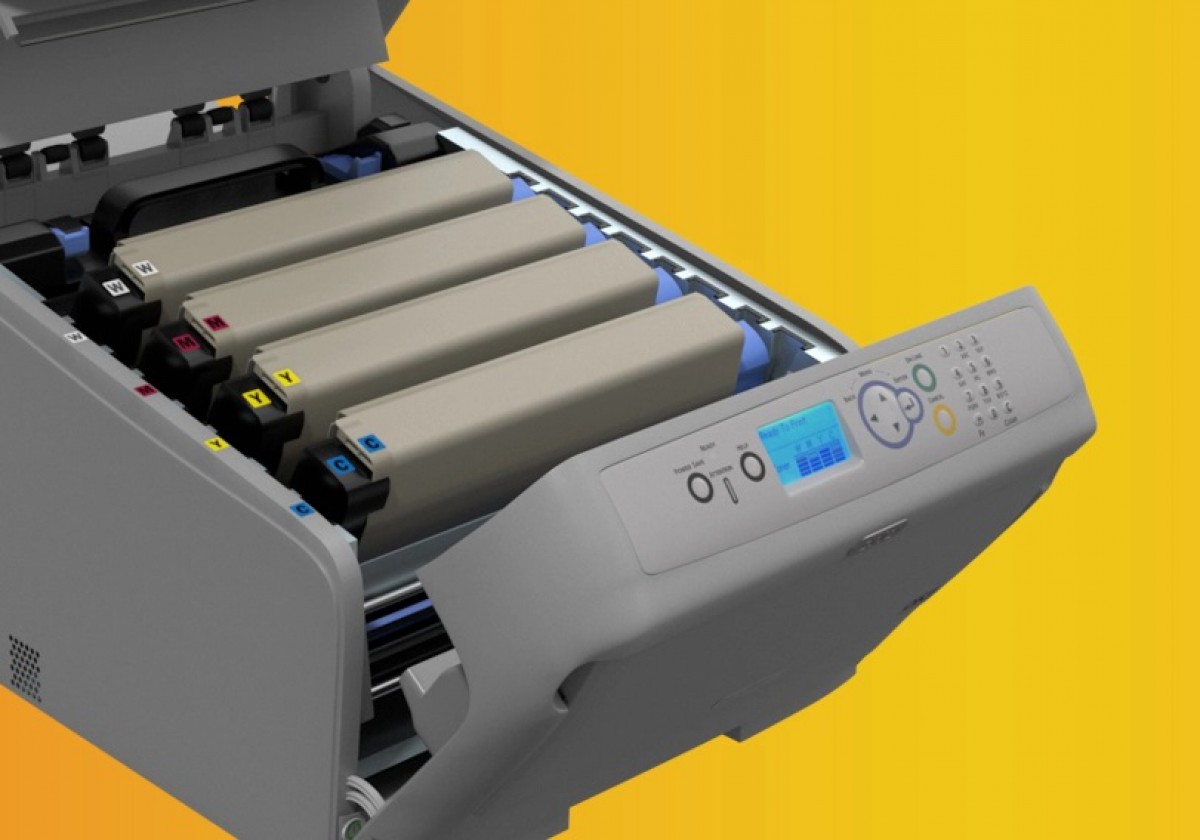White Toner Printer vs DTG: A Complete Comparison

Choosing Between a White Toner Printer and DTG Printing
When it comes to creating customized apparel, t-shirts, and other print-on-demand products, the method of printing you choose is vital.
Two popular methods are using a White Toner Printer or a Direct-to-Garment (DTG) Printer. It's important to carefully consider which method will be the best fit for your project as both options can be expensive investments. By evaluating the technical differences, benefits and costs between the White Toner Printer and DTG printing, you'll be able to make an informed decision that best aligns with your project and ultimately your business.
Let's explore the differences between White Toner Printing vs DTG.
What's the difference between DTG and white toner printer?
DTG stands for Direct-to-Garment printing, which is a type of digital printing technology that is used to print designs directly onto textiles, such as t-shirts, hoodies, and other clothing items. This is done by using a specialized printer that sprays tiny droplets of ink directly onto the fabric, which then bond with the fibers to create a high-quality, long-lasting print.
A white toner printer, on the other hand, is a type of printer that uses special toner that contains a white pigment, in addition to traditional cyan, magenta, yellow, and black (CMYK) toners. This allows the printer to print designs that include white text or images on colored or dark-colored materials.
DTG Printers are suited for small runs, with single or few pieces, and the cost per piece is usually higher than traditional screen printing or heat press methods. They are widely used for short runs, personalization, and on-demand printing because they can print full-color designs directly onto textiles with minimal setup or preparation.
White toner printers are widely used for printing with transfer papers, as they can print white designs on the transfer paper and then use heat press to apply the design onto textiles, ceramic, metal, and other substrates. They are ideal for small businesses, schools, and home-based businesses, and are particularly useful for printing designs on dark or colored materials.
Direct to Garment Process

The process of direct-to-garment (DTG) printing involves using large inkjet printers to print designs directly onto textiles, such as clothing. To ensure the ink adheres properly to dark-colored garments, a pretreatment spray is applied before printing. This step is not required for light-colored or white garments, but it can improve the final results.
The garment is then loaded onto a platen, where it is printed on directly. The time required for the printing process can vary depending on the specific DTG printer model used. For dark garments, a layer of white ink is typically applied first, followed by the desired colors.
Once the printing is complete, the garment must be heat-cured to set the ink.
Pros of DTG
Direct-to-garment (DTG) printing is a method that allows for high-resolution, full-color prints on textiles such as clothing. It eliminates the need for additional charges for multiple colors or setup fees as the shirt is printed digitally.
Additionally, DTG offers the convenience of on-demand printing, with most printers capable of completing a shirt in about 2 minutes. The print has a great durability and tend to last as long as the garment. To maintain the print, garments should be washed in cold water and hanged to dry.
DTG is ideal for small orders, as it does not require a minimum quantity and thus it allow for accept even one-offs and short runs. This way, it eliminates the missed revenue opportunities.
Cons of DTG
The process of Direct-to-garment (DTG) printing involves an additional step of pretreatment, which can be time-consuming and costly. Manually applying the pretreatment can result in inconsistencies and affect the quality of the print. The use of a pretreatment machine can also add to the expense.
Additionally, DTG printers, being inkjet printers, require regular maintenance to keep them in proper working condition. Printheads may clog and need to be replaced. Ink for DTG printers can also be costly, with certain printers requiring over $4.00 in ink for a colorful design on a dark garment.
The use of DTG printing is limited to certain types of fabrics, with garments being at least 50% cotton, and 100% cotton being ideal. Blended fabrics must have a majority of cotton for the ink to adhere properly. Additionally, DTG can only be used on garments and not on items such as drinkware, metal, wood, etc.
White Toner Transfer Process

White toner transfer is a method of printing in which images are printed onto special paper or film, and then transferred onto a substrate such as a garment. There are two types of paper used in this process: one-step paper for light-colored garments, and two-step paper for dark-colored garments.
For two-step paper, the image is printed onto a transparent film and then transferred onto an adhesive sheet using a heat press. The adhesive sheet only sticks to the toner, which is then pressed onto the garment and finished with a final press.
For one-step paper, the image is printed directly onto the paper, which is then pressed onto the garment and finished with a final press.
Pros of White Toner Printers
White toner transfer is a highly flexible and versatile decoration method, allowing for the creation of intricate and vibrant designs on a wide range of colors and substrates. You can use it to decorate cotton, polyester, poly-blends, denim, leather, wood, metal, acrylic, mylar balloons, and many other materials.
With a Crio printer, every transfer you create is an opportunity for profit. The process has no setup costs, and no minimum order quantity is required, meaning you can start producing and selling your designs right away. Simply turn on the printer, print your design through the RIP software, and apply it to a substrate, and you’re ready to earn a profit.
Unlike inkjet printers, Crio printers use dry, crushed toner and not ink. This means no clogged printheads to worry about, and you can even turn the printer off and back on again, and you will be ready to print.
White toner transfer also offers the added convenience that you can buy substrates at any local store and transfer your designs to them, unlike other methods which often require the use of specially coated materials or the need to check the compatibility of the material before starting the transfer process.
Cons of White Toner Transfers
Transferring to dark-colored garments takes longer than light-colored garments due to the need for two-step paper. Two-step papers require the extra step of “marrying” the A and B sheets.
White toner transfer requires a high-quality heat press. You cannot use a cheaply made press. You must be able to achieve even pressure and heat consistently.
Is Crio White Toner Right for Your Business?

If you're looking for an efficient, low maintenance, and versatile decoration method to start or expand your business, Crio white toner transfer is an excellent choice. Compared to DTG or DTF printers, Crio white toner transfer printers are less expensive in terms of startup and initial investment, and require little to no regular maintenance.
White toner transfer allows you to decorate an incredibly wide variety of substrates, if it can fit in a heat press, it can likely be transferred and decorated on. There are even papers which are specifically designed for heat-sensitive items and allows to create temporary tattoos, which is not possible with DTF or DTG.
Crio also provides exceptional printer and process support. We not only support our machines but also assist you through the entire transfer process. In case you have issues with a specific media, Crio is always ready to help, in addition Crio's support site has how-to videos, marketing kits, profit guides, a community forum, knowledge base, and more to ensure our users' success.
While each decoration method has its own advantages and disadvantages, if you're looking for a profitable, versatile method for personalizing garments and hard goods with no maintenance, Crio white toner transfer is the perfect option for you.
Final thoughts and review
A white toner printer operator who is able to adapt and excel in any situation is an "opportunity champion." This type of operator is able to produce a wide variety of fabrics and hard substrates, all with unique designs. They often operate out of a home-based or small retail setting, where space is limited and investment in printing equipment must serve multiple purposes. If custom garments and products are a key part of your business model, but demand does not consistently keep your DTG printer running, a reliable and efficient white toner system may be the solution you need.
White Toner Printer FAQ:
Q: What is a white toner printer?
A: A white toner printer is a type of printer that uses special toner that contains a white pigment, in addition to traditional cyan, magenta, yellow, and black (CMYK) toners. This allows the printer to print designs that include white text or images on colored or dark-colored materials and garments.
Q: How is white toner printer different from Direct-to-Garment (DTG) printing?
A: DTG is a method of digital printing technology that is used to print designs directly onto textiles, such as t-shirts, hoodies, and other clothing items by using a specialized printer that sprays tiny droplets of ink directly onto the fabric, which then bond with the fibers to create a high-quality, long-lasting print. White toner printers are used to print with transfer papers, which the design can then be applied onto textiles, ceramics, metal, and other substrates using a heat press machine.
Q: What are the benefits of using a white toner printer?
A: White toner printers are ideal for small businesses, schools, and home-based businesses, and are particularly useful for printing designs on dark or colored materials, garments, and a wide variety of substrates.
Q: What is the process of using a white toner printer?
A: The process of using a white toner printer involves printing designs using the special white toner on transfer papers. The design is then applied to the desired substrate using a heat press.
Are you leaving money on the table by under-pricing your custom products?
Did you know Conde has a pricing tool that gives you the suggested retail price range for our entire catalog of print-on-demand blank products?
Start here to learn more about our Retail Pricing Calculator Tool
